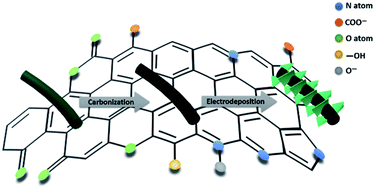当前位置:
X-MOL 学术
›
Sustain. Energy Fuels
›
论文详情
Our official English website, www.x-mol.net, welcomes your feedback! (Note: you will need to create a separate account there.)
Core–shell structural PANI-derived carbon@Co–Ni LDH electrode for high-performance asymmetric supercapacitors†
Sustainable Energy & Fuels ( IF 5.6 ) Pub Date : 2018-04-14 00:00:00 , DOI: 10.1039/c8se00123e Junming Cao 1, 2, 3, 4, 5 , La Li 1, 2, 3, 4, 5 , Yunlong Xi 5, 6, 7 , Junzhi Li 1, 2, 3, 4, 5 , Xuexue Pan 1, 2, 3, 4, 5 , Duo Chen 1, 2, 3, 4, 5 , Wei Han 1, 2, 3, 4, 5
Sustainable Energy & Fuels ( IF 5.6 ) Pub Date : 2018-04-14 00:00:00 , DOI: 10.1039/c8se00123e Junming Cao 1, 2, 3, 4, 5 , La Li 1, 2, 3, 4, 5 , Yunlong Xi 5, 6, 7 , Junzhi Li 1, 2, 3, 4, 5 , Xuexue Pan 1, 2, 3, 4, 5 , Duo Chen 1, 2, 3, 4, 5 , Wei Han 1, 2, 3, 4, 5
Affiliation

|
Carbon/metal nanocomposites have been considered promising electrode materials for application in supercapacitors owing to their combination of good electrical conductivity, excellent cycle stabilities of the electronic double layer capacitor (EDLC) and high specific capacitance of the pseudocapacitor. Here, a core–shell structured polyaniline derived carbon nanowire@Co–Ni layered double hydroxide (PANC@Co–Ni LDH) nanomaterial was successfully synthesized via a novel facile electrodeposition–carbonization–electrodeposition route. The core-like PANC full of N atoms retains its innate long-chain structure and provides a lot of active sites for the uniform growth of the shell-like Co–Ni LDH, resulting in a cross-linked active network structure with numerous electroactive sites, abundant pores, and adequate large space and reaction interface, which contribute to the rapid diffusion and transportation of the electrolyte ions and electrons. Therefore, as-obtained PANC@Co–Ni LDH showed a high specific capacitance of 1529.52 F g−1 at 0.5 A g−1 in a three electrode system and offered outstanding rate properties with no obvious capacitance attenuation (1425.17 F g−1) when the current density increased to 10 A g−1. Moreover, an asymmetric supercapacitor using PANC@Co–Ni LDH as the positive electrode and PANC as the negative electrode was fabricated, which revealed a high specific capacitance of 214.28 F g−1 and superior energy density of 38.73 W h kg−1 with a power density of 0.92 kW kg−1, suggesting great potential in practical energy storage devices.
中文翻译:

核-壳结构PANI衍生的碳@ Co-Ni LDH碳电极,用于高性能不对称超级电容器†
碳/金属纳米复合材料具有良好的导电性,电子双层电容器(EDLC)的出色循环稳定性和伪电容器的高比电容,因此被认为是有希望用于超级电容器的电极材料。在这里,成功地通过以下方法成功合成了核-壳结构的聚苯胺衍生的碳纳米线@ Co-Ni层状双氢氧化物(PANC @ Co-Ni LDH)纳米材料。一种新颖的简便的电沉积-碳化-电沉积路线。充满N原子的类核PANC保留了其固有的长链结构,并为壳状Co-Ni LDH的均匀生长提供了许多活性位,从而形成了具有许多电活性位的交联活性网络结构,丰富的孔隙,足够大的空间和反应界面,这有助于电解质离子和电子的快速扩散和传输。因此,所获得的PANC @ Co-Ni LDH在三电极系统中在0.5 A g -1时显示出1529.52 F g -1的高比电容,并且具有出色的速率特性,而没有明显的电容衰减(1425.17 F g -1)。当电流密度增加到10 A g时-1。此外,使用PANC @ Co-Ni LDH作为正电极,PANC作为负电极制备了一种不对称超级电容器,该电容器具有214.28 F g -1的高比电容和38.73 W h kg -1的优异能量密度,且具有功率密度为0.92 kW kg -1,表明在实际的储能设备中具有巨大的潜力。
更新日期:2018-04-14
中文翻译:

核-壳结构PANI衍生的碳@ Co-Ni LDH碳电极,用于高性能不对称超级电容器†
碳/金属纳米复合材料具有良好的导电性,电子双层电容器(EDLC)的出色循环稳定性和伪电容器的高比电容,因此被认为是有希望用于超级电容器的电极材料。在这里,成功地通过以下方法成功合成了核-壳结构的聚苯胺衍生的碳纳米线@ Co-Ni层状双氢氧化物(PANC @ Co-Ni LDH)纳米材料。一种新颖的简便的电沉积-碳化-电沉积路线。充满N原子的类核PANC保留了其固有的长链结构,并为壳状Co-Ni LDH的均匀生长提供了许多活性位,从而形成了具有许多电活性位的交联活性网络结构,丰富的孔隙,足够大的空间和反应界面,这有助于电解质离子和电子的快速扩散和传输。因此,所获得的PANC @ Co-Ni LDH在三电极系统中在0.5 A g -1时显示出1529.52 F g -1的高比电容,并且具有出色的速率特性,而没有明显的电容衰减(1425.17 F g -1)。当电流密度增加到10 A g时-1。此外,使用PANC @ Co-Ni LDH作为正电极,PANC作为负电极制备了一种不对称超级电容器,该电容器具有214.28 F g -1的高比电容和38.73 W h kg -1的优异能量密度,且具有功率密度为0.92 kW kg -1,表明在实际的储能设备中具有巨大的潜力。



























 京公网安备 11010802027423号
京公网安备 11010802027423号